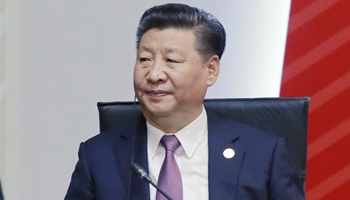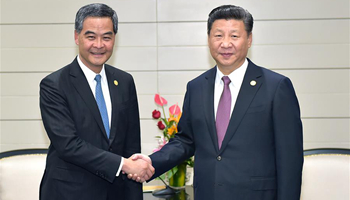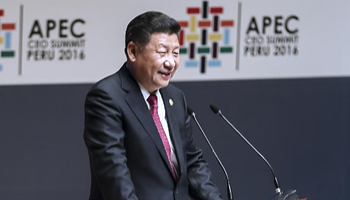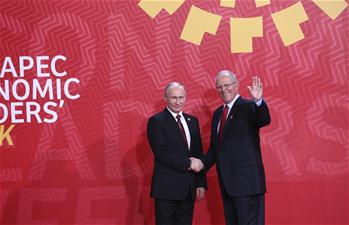by Xinhua writer Yuan Quan
BEIJING, Nov. 21 (Xinhua) -- Two years ago, Han Chunjing was an amateur chef, parading her attempts at China's world-renowned cuisine on social media.
Today, Han, 45, the founder of a Tianjin non-government organization, is one of the growing number of fitness enthusiasts posting gym selfies to show off her sweating physique.
Since September 2014, she has worked out four to six hours a week, and focused on training programs including crossfit and cardio sessions. She has lost 10 kg, firmed her abs, and, more importantly, "regained a young woman's shape and confidence".
She is one of the millions of Chinese who have taken up the Western habit of boasting their beautiful butts, six packs and well-honed musculature through anaerobic or aerobic exercises.
Some say the trend is driven by the increasingly ripped stars in Hollywood blockbusters and spread on social media.
Pictures of running tracks, steps, and amazing handstands are sweeping microblog Weibo and Twitter-like WeChat. Registration for some marathons is harder than buying a train ticket for the Spring Festival. Web users never tire of discussing body fat percentages and diet plans. Celebrities' posts of their gym pictures always attract hits and fans.
But Han says her passion came from her own awakening: "Keeping fit means a better life."
Fitness classes, books and sportswear have cost her more than 30,000 yuan over two years: "It's not a small amount, but it's better than spending it on hospital bills, isn't it?"
When she was young in the 1980s, most people had no awareness of physical fitness, believing the traditional saying that "Health depends on food rather than feet."
SICKNESS AND WEALTH
Lin Xianpeng, vice director of the Management College of Beijing Sport University, says the trend is due to fears about worsening health.
"Almost half the Chinese population is sub-healthy; millions people have chronic ailments; the cases of both diabetes and cardio-cerebral vascular diseases have reached 190 million," says Lin.
Furthermore, insomnia and obesity rates have exceeded those of developed countries, and their continued rise is spreading among younger people.
"We need to be clear that, though China is getting rich, its people's health should not be poor," Lin says. "China should avoid being the sick man of Asia again."
Public awareness of fitness begins when a nation's GDP per capita hits 5,000 U.S. dollars, says Liu Qing, deputy secretary-general at Chinese Association of Sport Industry. Should it surpass 8,000 U.S. dollars, the fitness industry will be a pillar of the national economy.
China's GDP per capita exceeded 5,000 U.S. dollars in 2011 and reached 8,016 U.S. dollars last year, according to official data.
In 1995, the government issued the "Outline of Nationwide Physical Fitness Program", pledging sports and health-building services would be aligned with national economic development.
Since then, all national five-year plans have included programs on public fitness. Sports facilities, stadiums and games have entered a period of rapid growth.
In 2014, the government updated the fitness program into a national strategy.
In June, it released the national fitness program for 2016-2020, forecasting 435 million people will regularly play sport and the total sport-related consumption will reach 1.5 trillion yuan by 2020.
Sport will become the new engine to boost domestic spending in a slowing economy, said Liu Peng, Minister of China's General Administration of Sport.
EXERCISE ONLINE
The fitness fad coincides with the growth of mobile Internet and a boom in entrepreneurship.
Xiong Mingjun started running a yoga app in September 2015. The experienced Internet CEO named his product "Wake".
Xiong has never practiced yoga, "but I know it is in great demand."
His confidence grew with the news that Premier Li Keqiang and Indian counterpart Narendra Modi had attended a cultural activity featuring taiji and yoga in Beijing last year.
Xiong made a slogan: "Yoga changes life." He thought yoga's physical and mental practices would satisfy the urge of middle class people to disengage from work, relax and slow down.
In a year, the app has gathered 2 million followers, mainly from Beijing and Shanghai, who can try yoga anytime anywhere through free videos on their mobile phones.
An estimated 1,700 Chinese sports and fitness apps have come online over the past two years. Most of them are startups aimed at beginners.
Companies offline are also competing for a share. Smartphone makers constantly release fitness tracking bracelets; restaurants offer expensive low-calorie dishes; real estate developers sponsor customers to run marathon races abroad.
Fitness instructors are also in demand.
Lin Shuo, 28, born in Shantou, Guangdong Province, has gained online celebrity riding the fitness wave. The professional athlete-turned-fitness guru started blogging on Weibo and WeChat in 2014, sharing his expertise and his gym experience.
"I never expected that my blogs would become an instant success," says Lin, who has 640,000 followers.
He resigned his post at a private company to launch a WeChat account called "Body Philosophy".
"Articles about how to chisel away body fat through exercise always receive thousands of hits," he says.
However, other experts urge caution in following online workouts.
"Videos and photos can show you how to move, but they cannot tell how to breath or how strenuous your exercise should be," says Shao Xiaofeng, a senior fitness instructor at a Beijing gym. "Everybody is different, so fitness needs face-to-face instruction."
Shao says exercise is also a social activity among white-collar workers who live alone in big cities. "Some trainees find dating or business partners. They can't do that watching mobile phone at home."
Three years ago, he led 24 gym classes a month, but now the number is 50. His income has doubled, but he must compete against cheaper, unqualified services.
To stay competitive, Shao attends fitness conferences, strives for higher accreditation, and studies medicine, nutrition, anatomy and psychology.
Shao once considered running his own gym in Beijing, but the expensive rent turned him off: "Gyms in big cities are usually set up underground, because of the low rent."
Most Chinese gyms offer long-term memberships, usually for six months or a year, to offset the high cost. The fees can run to thousands of yuan - beyond the means of many people.
But coaches are optimistic about the future. "It is a budding industry. The competition will become more professional, and consumers more sensible," says Shao.
After all, a popular saying in China has it that "Breaking a sweat deserves a feast."











